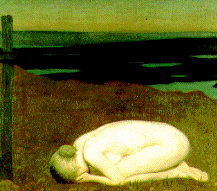 This painting is "Youth Mourning" (1916) by Sir George Clausen (1852-1944). He was originally commissioned to do scenes from the front and paintings depicting the war effort at home. One of his notable paintings of this sort is a large canvas entitled "In the Gun Factory at Woolwich Arsenal," which pictures Britain's most important munitions factory and its workers casting barrels for artillery pieces. "Youth Mourning" is not, however the propaganda piece that "Woolwich Arsenal" is; it shows a much more personal response to the war.
This painting is "Youth Mourning" (1916) by Sir George Clausen (1852-1944). He was originally commissioned to do scenes from the front and paintings depicting the war effort at home. One of his notable paintings of this sort is a large canvas entitled "In the Gun Factory at Woolwich Arsenal," which pictures Britain's most important munitions factory and its workers casting barrels for artillery pieces. "Youth Mourning" is not, however the propaganda piece that "Woolwich Arsenal" is; it shows a much more personal response to the war.In the detail of the painting (poorly reproduced, I fear), we see a naked young girl kneeling and crying before a wooden cross. The imagery is powerful: her nakedness, set against a barren landscape, suggests an unfulfilled sexuality now denied because so many young men have died at the front. The cross suggests the grave, but it also hints at the image of the crucified and sacrificial Christ-like soldiers we encounter elsewhere in the poetry. The painting might finally symbolize the mourning of all young women for the lovers and husbands lost and a generation of babies that will never be born.
Many of Clausen's paintings were exhibited during the war, but "Youth Mourning" was not given to the Imperial War Museum for exhibition until 1929, eleven years after the war ended.